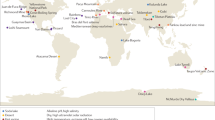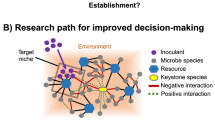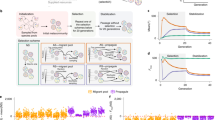Abstract
THE importance of micro-organisms as agents of biochemical transformations in natural environments is well established. But micro-organisms are small and thus their environments are also small, so that micro-organisms can be investigated directly in Nature only by the use of the microscope. Although the microscope can be used to see where various organisms are situated in a micro-environment and how organisms are disposed with relation to one another, one cannot, however, study microscopically many of the characteristics of an organism which are of greatest ecological interest: that is to say, nutritional requirements, responses to environmental changes, production of metabolites and growth rate. The usual approach for the study of these latter phenomena has been to isolate micro-organisms in pure culture and attempt to infer from the behaviour of the pure culture the behaviour of the parent organism in Nature. However, it is clear that the behaviour of the pure culture reveals the potentiality of the organism in Nature, but does not show what the organism was actually doing, since the organism has undoubtedly adapted to the cultural conditions used. Further, even if the laboratory conditions precisely mimic the natural conditions, the laboratory environment cannot reproduce the natural environment, since the natural environment contains the additional elements of competition and co-operation with other organisms.
This is a preview of subscription content, access via your institution
Access options
Subscribe to this journal
Receive 51 print issues and online access
$199.00 per year
only $3.90 per issue
Buy this article
- Purchase on SpringerLink
- Instant access to full article PDF
Prices may be subject to local taxes which are calculated during checkout
Similar content being viewed by others
References
Prescott, D., Methods in Cell Physiology (Academic Press, New York, 1961).
Appleton, T. C., J. Roy. Micros. Soc., 83, 277 (1964).
Author information
Authors and Affiliations
Rights and permissions
About this article
Cite this article
BROCK, T., BROCK, M. Autoradiography as a Tool in Microbial Ecology. Nature 209, 734–736 (1966). https://doi.org/10.1038/209734a0
Issue date:
DOI: https://doi.org/10.1038/209734a0
This article is cited by
-
Substrate uptake in extremely halophilic microbial communities revealed by microautoradiography and fluorescence in situ hybridization
Extremophiles (2003)
-
Radioactive labeling of a natural assemblage of marine sedimentary bacteria and microalgae for trophic studies: An autoradiographic study
Microbial Ecology (1990)
-
Potential commercial applications in aquatic microbiology
Microbial Ecology (1986)
-
Autoradiographic study to detect metabolically active phytoplankton and bacteria in the Rhode river estuary
Marine Biology (1977)



